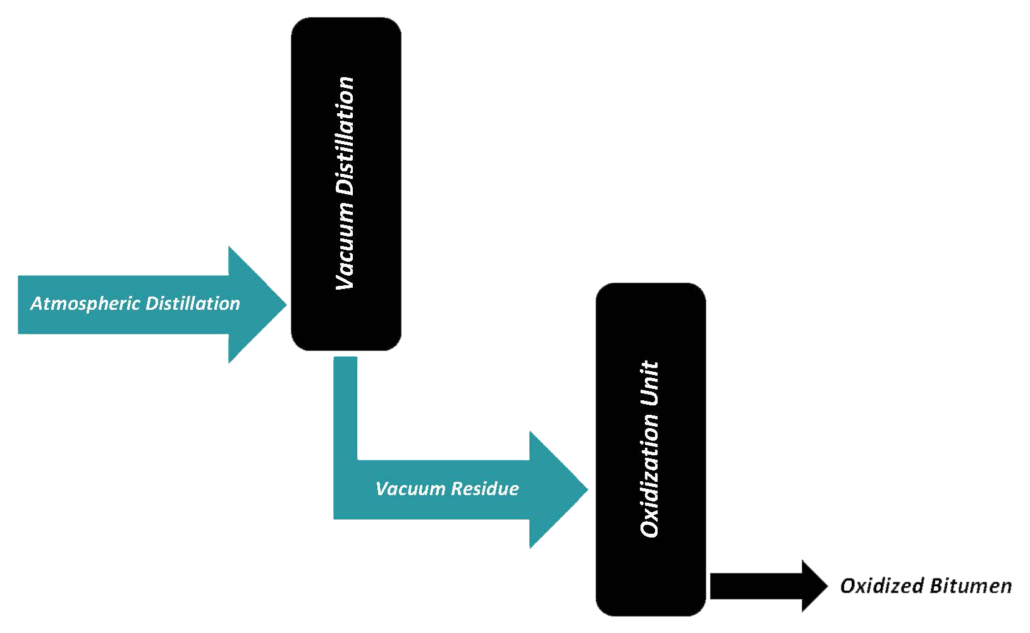How to Blow air into Bitumen
Bitumens are modified by blowing air. It is an oxidation process that involves blowing air into the bitumen, either in batches or continuously, with a short residue at 240 ° C to 320 ° C.
The process of blowing air is as follows:
After preheating, the short residue enters the blower column just below the normal liquid level. The air is blown through bitumen by an air distributor at the bottom of the column. Air is not only reactive but also serves to stir and mix bitumen, thus increasing the level and speed of the reaction. As air rises through the material, oxygen is consumed by the bitumen. Steam and water are sprayed in the steam room above the surface of the bitumen, the former to suppress the foam and expand the oxygen content of the waste gases and the latter to cool the vapors to prevent it from burning. The “blown” product flows from the bottom of the blower column through an external traction line to a wave drum. In this way, the minimum product level in the blower column is controlled.
Before pumping the product for storage, the blown product is passed through heat exchangers to reach the desired “drop” temperature and provide a suitable means for preheating the short residue. Infiltration and softening of blown bitumen are affected:
- The viscosity of raw materials
- The temperature in the blower column
- Origin of crude oil used to produce raw materials
- Air to feed ratio
The blowing process shortens the wastewater, resulting in oxidation and polycondensation, increasing the overall molecular size of the asphaltene in the feed, and excess asphaltene is formed from the malting stage. The reaction is exothermic. Therefore, close temperature control of this process is necessary, which is achieved by adjusting the ratio of air to short in the blower column.
Modified or semi-blown bitumen
To produce bitumen with a suitable degree of penetration for road construction, bitumens produced from some raw materials require a limited amount of air blowing. This process is called half-blowing or air correction. With rational use, half-blowing can be used to reduce the bitumen temperature sensitivity, i.e. to increase its penetration index.
Bitumens that have been completely blown
Fully blown or oxidized bitumen is produced by the intense blowing of a short residue or short residue mixed with a heavy distillation agent. The position of the blowing curve depends primarily on the viscosity of the feed, i.e. the softer the feed, the higher the curve. The intensity of the blow depends on the temperature of the column and to a lesser extent on the residence time. Therefore, by controlling the feed viscosity and conditions in the column, all grades of blown bitumen can be produced.
Oxidized Bitumens
Oxidized bitumens are almost entirely used for industrial applications, for example, roofing, flooring, pipe coating, paints, etc. 85 + -5 ºC and penetration 40 + – 5.
Chemistry of the blowing process
The purpose of the blowing process is to form asphaltene. Three phenomena can be identified:
- Reactions during which the size of molecules increases. The formation of esters is especially important. They not only make up about 60% of the oxygen in the blown bitumen, but also bind two different molecules together, thus helping to form a higher molecular weight substance. This mechanism leads to an increase in asphaltene content and a change in the colloidal chemical structure and rheological properties of bitumen.
- Reactions in which the size of the molecule is unchanged. Formation of cyclic hydrocarbons using dehydrogenation with H2O as a by-product
- Reactions during which the size of the molecule decreases. Separation of lateral branches from molecules by blown distillation, which is produced as a by-product.

